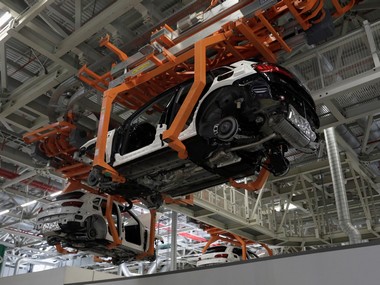India’s economic growth dropped to a six-and-half-year (26-quarter) low at 4.5 percent in the July-September quarter of 2019-20 due to a sharp deceleration in the manufacturing, agriculture, construction sector, according to official data released on Friday. Experts had predicted, GDP growth for Q2 to be between 4.2 percent and 4.7 percent, slower than the 5 percent in Q1. Economists in a Reuters poll had
expected GDP to grow at 4.7 percent in the September quarter. While
SBI research had predicted that GDP growth would dip to 4.2 percent in Q2, rating agency
ICRA had forecasted it at 4.7 percent . The previous low was recorded at 4.3 percent in the January-March quarter of 2012-13. The economic growth was 7 percent in the same quarter of 2018-19. It had dipped to over
six-year low of 5 percent in April-June quarter of 2019-20. [caption id=“attachment_7289551” align=“alignleft” width=“380”] Representational image. Reuters.[/caption] “GDP at Constant (2011-12) prices in Q2 of 2019-20 is estimated at Rs 35.99 lakh crore, as against Rs 34.43 lakh crore in Q2 of 2018-19, showing a growth rate of 4.5 percent,” the National Statistical Office (NSO) said in a statement. Quarterly GVA at Constant (2011-2012) prices for Q2 of 2019-20 is estimated at Rs 33.16 lakh crore, as against Rs 31.79 lakh crore in Q2 of 2018-19, showing a growth rate of 4.3 percent over the corresponding quarter of previous year, it said. The gross value added (GVA) growth in the manufacturing sector tumbled to negative 1 percent in the second quarter of this fiscal from 6.9 percent expansion a year ago. Similarly, farm sector GVA growth remained subdued at 2.1 percent as compared to 4.9 percent in the corresponding period of the previous fiscal. Construction sector GVA growth too slowed to 3.3 percent from 8.5 percent earlier. However, mining sector growth marginally rose to 0.1 percent from negative 2.2 percent a year ago. Gross fixed capital formation (GFCF), which is a barometer of investment, at constant (2011-12) prices was estimated at Rs 11.28 lakh crore in the second quarter as against Rs 11.16 lakh crore a year ago. In terms of GDP, GFCF at current and constant prices during the second quarter was estimated at 27.8 percent and 31.3 percent respectively, as against 29.2 percent and 32.4 percent a year ago. In October monetary policy, the
Reserve Bank had sharply lowered the GDP growth projection for 2019-20 to 6.1 percent from 6.9 percent projected earlier in the August policy, and underlined the need for addressing growth concerns by boosting aggregate demand. The central bank had expressed hope that the growth will recover in the second half of 2019-20.
“Taking into account the baseline assumptions, survey indicators, reductions in the policy repo rate since February 2019, the base effects and model forecasts, real GDP growth is projected at 6.1 percent in 2019-20 – 5.3 percent in Q2, 6.6 percent in Q3, 7.2 percent in Q4 – with risks evenly balanced,” RBI had said in the monetary policy statement. China’s economic growth was at 6 percent in July-September quarter of 2019, which was the weakest expansion in almost 30 years. Earlier in the day, the government data showed that output of
eight core infrastructure industries contracted by 5.8 percent in October, indicating the severity of economic slowdown. As many as six of eight core industries saw a contraction in output in October.


)
)
)
)
)
)
)
)
)



